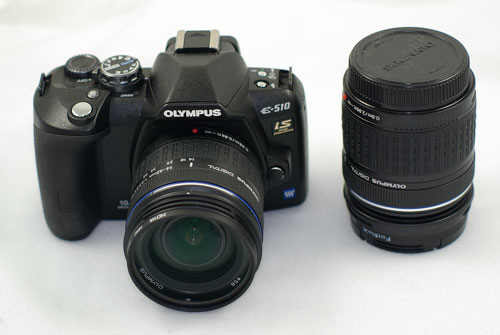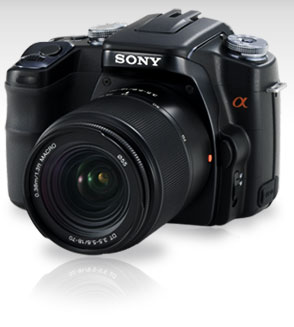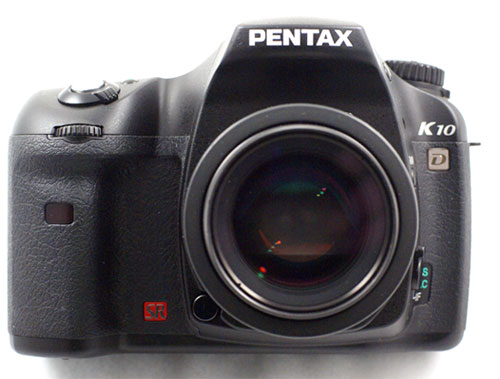Digital Camera Buyers' Guide - Year of the SLR
by Wesley Fink on November 23, 2007 6:00 AM EST- Posted in
- Digital Camera
Entry-Level Recommendations
Entry-level buyers don't normally have a collection of lenses for their new camera, so they are usually shopping for kits. Kit lenses are notorious for being mediocre, but that is improving in some of the kits we have recently seen. Our recommendations considered the quality and value of the kit itself, as well as the lens system for the entry DSLR buyers who end up enjoying digital photography and want to grow.

We are getting ready to be stoned, as our recommendation for best value in a kit is the 2-lens Olympus E-510 kit. The picture above is the complete kit, with both the 14-45mm f3.5-5.6 and tiny 40-150mm f4.0-5.6. These two small and light lenses cover the 35mm equivalent of 28mm to 300mm - a range from true wide angle to moderate telephoto. The 510 system finally realizes the promise of 4/3 with a small light body and small light lenses, but these two lenses are also two of the finest quality kit lenses available anywhere. This two-lens kit is available for as little as $675 at Amazon.com with free shipping, and you will find the E-510 two-lens kit at many web and brick-and-mortar stores for less than $800.
You get all the checklist features in this 10MP DSLR kit. This includes auto sensor cleaning and Live View as well as body integral image stabilization that works with all 4/3 lenses. This image stabilization - a first for Olympus - is selectable for either horizontal motion, which is generally best for panning and action, or both horizontal and vertical for general use, or off.
Olympus has improved their autofocus modules with each new generation, and the E-510 is the best one yet (outside of the E-3). However, the autofocus is still a weakness in an otherwise very capable system. It uses the somewhat dated 3-point autofocus, with a center cross sensor for greater sensitivity. In normal light, the E-510 is just as accurate and fast as other cameras, but it tends to search too much in low light conditions. Olympus introduced a fast and innovative 11 cross point 4-plane AF module in their new E-3. It needs to move down the line quickly to fix the last remaining issue with Olympus DSLR cameras. However, your reward with the E-510 is gorgeous, sharp, and evenly lighted lenses with the two kit lenses - and that is what photography is about.


Alternative: If low-light performance is a major concern, then you would do well to choose the Sony A100 kit with the 18-70mm kit lens. For a bit more money, the Pentax K10D gives you a great 11-point auto focus module, the truly useful hyperprogram feature that allows front and back dials to shift aperture and shutter speed in equivalent program steps, 3-plane image stabilization, all the other features, PLUS pro-type dust and moisture sealing.
The Safe Choice: The safe choice, and the one most buyers will make, is the Canon Rebel XTi or the Nikon D40x with the pedestrian 18-55mm kit lens. The problem with either choice is they don't include image stabilization, which is most useful with the slow kit lenses most camera makers sell with their entry cameras. In their favor, Canon includes auto sensor cleaning, but Nikon doesn't even bother with that. Nikon does provide a bit better image quality with their 18-55mm, so that makes it something of a toss-up.
It appears both Nikon and Canon are being hurt somewhat by their lack of mechanical image stabilization since they have both announced the availability of their basic kit lens with optical image stabilization. Yes, you will be seeing these IS and VR versions of the 18-55mm in future Canon and Nikon kits. There are arguments that can be made for optical IS instead of the mechanical body-integral IS that works with all lenses. However, the thought of spending more for the Canon 18-55mm with IS is difficult to stomach. What these announcements really say is Canon and Nikon are still resisting IS as a standard feature, though they are addressing this as a checklist item with IS/VR versions of their entry kit lens.










74 Comments
View All Comments
Wesley Fink - Tuesday, November 27, 2007 - link
I'm sure the answer to a better Photo Editor would be you. We understand you are disappointed that Anand did not hire you to write for AT, but the years of criticizing the Editors he did choose to hire is getting very tiring. You really need to get over it and move on.KorruptioN - Tuesday, November 27, 2007 - link
Burn.strikeback03 - Monday, November 26, 2007 - link
The Sigma lenses for 4/3 are not designs purely for 4/3 as the Oly lenses are - they are mount adaptations of existing lenses such as the Bigma.Some notes on the different implementations of AF in Live View between the different manufacturers might have been useful, as well as noting that the best AF performance will still be obtained through use of the real viewfinder.
Finally I agree with the need to go physically try a camera before buying. For example the reviews at DPReview typically complain about the grip of the 400D/XTi, while praising the A100. However I find that the 400D is much more comfortable as my pinkie just curls up below the body, while on the A100 the grip is too long to do that, but too short for the pinkie to actually grab, so my pinkie just kinda hangs in space.
melgross - Monday, November 26, 2007 - link
[quote]The Sigma lenses for 4/3 are not designs purely for 4/3 as the Oly lenses are - they are mount adaptations of existing lenses such as the Bigma. [/quote]That's correct.
As far as I'm concerned, the 4/3 system, which I was initially excited about upon its announcement, is not worth the long term purchase of the equipment.
Olympus could have used the image circle of the APS C sensor for a larger image sensor, which could have been done, but chose not to. So, instead of having a magnification of possibly 1.4 to 1.3x, it's 2x. A poor choice. Also, if they hadn't done that, all APS C sensor lenses would have the same magnification as Olympus's lenses, and better S/N, rather than worse.
As they made no concession to size when designing the cameras and lenses for this system, there is no advantage there either.
It seems to be a bastard system to me, and conveys no advantage.
frombauer - Monday, November 26, 2007 - link
... the largest (or tiniest) problem with 4/3 cameras like the Olympus. The ridiculously small and dim viewfinder. It's like looking through a small tunnel. Simply not practical. Just looking at any Nikon or Canon VF makes a world of a difference. I'm not even talking about the 5D.Wesley Fink - Monday, November 26, 2007 - link
I generally agree, and even the Pro E-1 was pretty small and dim. However,Look throught the E-3 viewfinder with a standard 1.15x viewfinder. I suspect any doubts that a 4/3 viewfinder can be huge, bright, and very easy to use will disappear. It took a few years but the E-3 viewfinder is definitely a huge leap forward for the 4/3 system.Johnmcl7 - Saturday, November 24, 2007 - link
The Digilux 3 is the Leica branded version of the Panasonic DMC-L1 and they're both relatively hefty cameras when compared to the smaller E-410/E-510 cameras or even their Olympus sibling the E-330. Although not anywhere near as big as something like the 5D, the Digilux 3 is bigger than the E-510.The Digilux 2 was a smaller camera (Leica version of the Panasonic LC-1) which may be the one you're thinking of although this wasn't an SLR despite the similarity in design to the L1/Digilux 3.
Also, the E-3 doesn't have a lens cleaning feature:
"The E-3 is also the first Olympus pro model to feature built-in flash, and it's dust and splash sealed. Auto lens cleaning is a feature, image stabilization is built in and works with all lenses, and the latest incarnation of Live View with a fold out articulating LCD screen is featured."
I assume you're referring to the sensor cleaning feature?
This section refers to the E-510 having multiple cross type sensors:
"However, the autofocus is still a weakness in an otherwise very capable system. It uses the somewhat dated 3-point autofocus, but cross sensors provide for greater sensitivity. "
Or at least that's how I read it, of the three AF points only one of them is a cross type (the centre one) while the other two are vertical only.
John
Johnmcl7 - Saturday, November 24, 2007 - link
...turns out it was posting them despite it erroring and not showing initially...Wesley Fink - Saturday, November 24, 2007 - link
Yes I was thinking of the 2 as they long similar. Thanks for the info. I have corrected the reference.Johnmcl7 - Sunday, November 25, 2007 - link
Thanks for the correction, the other errors (E-3 lens cleaning and E-510 AF) are still there though.John